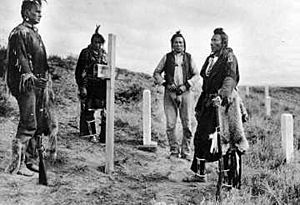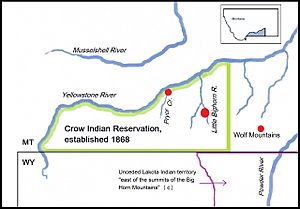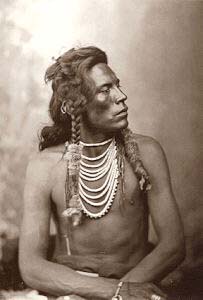Crow scouts facts for kids
Quick facts for kids Crow Scouts |
|
|---|---|

Crow scouts visiting the Little Bighorn battlefield, circa 1913. From left to right; White Man Runs Him, Hairy Moccasin, Curly and Goes Ahead. Joseph Medicine Crow explained the main reason for men like these to enlist. They scouted against a long time Indian enemy, "... who were now in the old Crow country, menacing and often raiding the Crows in their reservation camps."
|
|
| Active | 1876 - 1879 |
| Allegiance | |
| Branch | United States Army |
| Type | Indian scouts |
| Engagements | Great Sioux War |
| Commanders | |
| Notable commanders |
James H. Bradley, George A. Custer, Nelson A. Miles, Charles A. Varnum |
The Crow Scouts were a group of Native American warriors from the Crow Nation. They worked with the United States Army in the late 1800s. The Crow people were at peace with the U.S. government at this time. This allowed their warriors to help the army in conflicts against other Native American tribes. These tribes were often enemies of the Crow, and sometimes entered Crow lands. The Crow Scouts played an important role in several wars, including the Great Sioux War of 1876.
In 1873, the Crow asked the U.S. military for help. They reported that other tribes were trespassing on their new reservation lands. A small group of Crow scouts saw General George A. Custer's defeat. This happened at the Battle of the Little Bighorn, which was on the Crow reservation. Many Crow scouts also fought in the Nez Perce War in 1877. They fought again in the Bannock War the next year. Some Crow scouts rode with Colonel Nelson A. Miles in 1879. They helped him search for Sitting Bull north of the Missouri River.
Contents
How the Crow Scouts Started
The U.S. Army was allowed to enlist Native American scouts starting in 1866. This was part of a new law. These scouts were paid the same as regular cavalry soldiers.
The Treaty of Fort Laramie (1851) said that lands west of the Powder River belonged to the Crow. However, the Lakota people also used this area for bison hunts. They still thought of it as their land. After 1868, the Crow lived on their new reservation in Montana. This area was in the middle of the 1851 treaty lands.
Crow Guides on the Yellowstone River
In 1871, three Crow guides joined an expedition. This group was surveying for the Northern Pacific Railway along the Yellowstone River. Their names were Blackfoot, Wolfbow, and Pretty Lodge. It is not clear if they were officially enlisted as scouts. Blackfoot and Wolf Bow may have been experienced warriors who had helped the army before.
Crow Scouts in Major Conflicts
Crow scouts helped the U.S. Army in several important battles. Their knowledge of the land was very helpful.
The Great Sioux War
Many Crow warriors joined the U.S. Army at the start of the Great Sioux War in 1876.
Crow Scouts with James H. Bradley
On April 10, Lieutenant James H. Bradley officially enlisted 23 Crow scouts. Each scout wore a red armband on their left arm. This helped soldiers tell them apart from other Native Americans. Three weeks later, the Sioux took all their horses. This made it hard for the Crow scouts to move around. A few days later, Half Yellow Face and Jack Rabbit Bull returned. They had captured three Sioux horses. Lieutenant Bradley wrote about how sad the Crow scouts were after Custer's defeat.
Crow Scouts with George Crook
About 170 Crow warriors fought with General George Crook. They were at the Battle of the Rosebud. They were not officially registered as scouts at that time.

Crow Scouts with George Armstrong Custer
Crow scouts led Custer's expedition to the Little Bighorn in the summer of 1876. Custer wrote to his wife that he had Crow scouts. He said they knew the area well. Charles A. Varnum, Custer's chief of scouts, also noted that the Crows were in their own country.
A year after the battle, Hugh Lenox Scott visited the battlefield. He went with all the Crow scouts who had served Custer. Decades later, in 1909, White Man Runs Him shared a story. He said he and Hairy Moccasin saved Custer's life earlier in the fight. They fired quickly at the charging Cheyenne warriors.
Crow Scouts with Nelson A. Miles
In late December 1876, Crow scouts killed five Lakota peace delegates. These delegates were under a flag of truce. This caused fighting to start again in the Yellowstone area. Crow scouts continued to help the army find enemy camps. Three Crow scouts fought against Lakotas and Northern Cheyennes. This was in the last battle of the Great Sioux War. It happened in the Wolf Mountains on January 8, 1877.
The Crow War of 1887
In 1887, some former Crow scouts were involved in a short conflict. This was called the Crow War, also known as the Sword Bearer uprising. The United States Army fought against some Crow warriors. This battle happened just north of the Little Bighorn battlefield.


